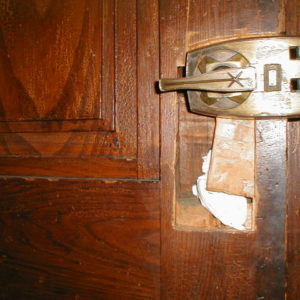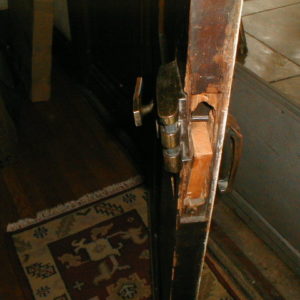The previous owner of my house decided that the original mortise lock should be replaced with two deadbolts. He had some “handyman” remove the original lockset and install one unit, then bored a large hole for the second unit. Based on the style I would guess this was done in the 70s. The door was a bit too thick for the new lock so they chiseled it out to fit. The inside face of the door also has a chunk of wood missing.
Other than the holes in the door (and the ugly lockset), the door is solid and looks good. I want to put in a lockset that matches the age of the house (1910), but need to patch up this hole first. What is the best way to patch it? I was thinking of making a template then routing out a clean hole (rabbitted or finger jointed) then filling it with new wood the full width of the door. Once that is done a new hole can be bored to fit the new lockset. The front of the door will be painted, but the inside will be stained.
What is the best way to make a patch that fits the hole and how should I attach it?

















Replies
Well you certianly can fix it but you have your work cut out for you. The face bores are the most visable and if you want to stain the interior I would suggest that you remove the entire face of the stile back to the sticking detail about 1/4" deep from the top to the bottom and resaw and laminate a new face on the stile. I have done this with great sucess on many occasions and find it to be the easiest way to repair a badly damaged face. The edge can be plugged with a reasonably sized plug shaped to fit the hole and epoxied in place. Do this repair prior to the face cut and it will help simplify the plug fit. As for the painted side of the door a fairly well cut plug and good old Bondo (yeah the body filler) to smooth the face will work fine because you are painting the exterior. It will take quite a few clamps and a substancial caul to relaminate the face but otherwise the project shouldn't require much else. I use a dado to cut the stile face off in multiple cuts and clean up with a hand plane
I was ready to give you Joe's suggestion but he beat me to it. The only thing I might do differently is use a router to take off the 1/4" of the stile. If you can get the router to run on an absolutely flat surface, it should be able to take off the 1/4" and leave you a perfectly flat stile to use for the lamination.
The only other potential problem is getting the "new wood" on the stile to match the current finish on the door. This probably means refinishing the entire door. I'd also keep a scrap of the lamination material to use for test staining/finishing.
Good luck.
John
Matthew... as a locksmith I have faced this problem several times. I am assuming that you want to replace the existing lock with a mortice lock. Most exterior doors are 1 3/4" in thickness and most mortice locks range in thickness from 7/8 to 1 1/8" in thickness. The patches do not have to be thick, but the jointery has to be strong. purchase the lock that you are going to use before you start this project. That way you will know where the lock plates are going to cover the area you are about to repair. Let's tackle the outside of the door first since you are going to paint it. Get a router bit & bushing set used to make 'dutchmen' or patches. You may want to make your own pattern to fit slightly larger than the butchered area. Be sure some of the patch is on 'solid' wood as it will help reinforce the repair. Make the outside patches aprox 1/4" thick. Glue these patches in place with a GOOD strong glue. There are many different styles of lock-sets. If you get one with large front and rear plates, the plates will cover or hide most of the worked area. Now that the outside is done, try to find a piece of wood that will match the grain and type of wood for the inside finished area. Again, use the same proceedure. Since you want to restore the mortice lock into the door, most of the hole will be available for the new lock body. If you have to expand the width of the mortice hole, use sharp chisels and SLOWLY open the sides. Your lock will come with templates that will show the exact height, depth and width of the mortice. It will also show where you have to drill for the knobs, lock cylinder, and if needed, the thumb latch or latches. It's not hard to do, just time consuming. If you need more info, drop me an e-mail and I'll try to give you more detailed info. SawdustSteve
Now that the outside is done, try to find a piece of wood that will match the grain and type of wood for the inside finished area.
Yeah right. I have yet to work on a door (doing them exclusvely for the past 10 years)where a dutchman the size he needs is even remotely close to an acceptable match. I believe I will save dutchman repairs for places where they aren't so obvious.
The only way I would consider this was if the escustions were larger than the hole that was being covered on the face and then I would fill the mortise so the material had something to adhere to
Joe
I have been thinking of the suggestions so far and have some questions. Wouldn't the strongest repair be to cut out the the area with the holes (about 6in x 4in) for the full width of the door and put a new piece in? Won't that be stronger that laminating just 1/4in over the hole?
Matching grain would be hard, I don't even know what species of wood it is. I was thinking of using some acrylic touch up paint to make my own grain. That way it will blend right in (but would that look odd?)
Thanks
The suggestion Joe and I had was to replace 1/4" of the entire stile on the interior. Clearly that would require you to find out the kind of wood and use the same wood for the lamination.
Simply cutting out the hole for the entire width (I take this as thickness) of the door would leave not only an ugly patch but IMO you'd have difficulty getting a patch to bond well with the current door. Epoxy would be the material of choice here. But this type of patch would be extremely obvious and wouldn't look good.
John
Depends on how much you love the door and how much time you have to devote to it. If you love it a lot, you might want to consider replacing the entire stile as this is probably (aside from trying to veneer the whole stile) the only way to not have a patch that shows. Veneering the whole thing is possible, but dicey and may not entail much less time or effort than replacing the stile. Either way, you gotta love that door.
Good luck.
Wayne
This forum post is now archived. Commenting has been disabled